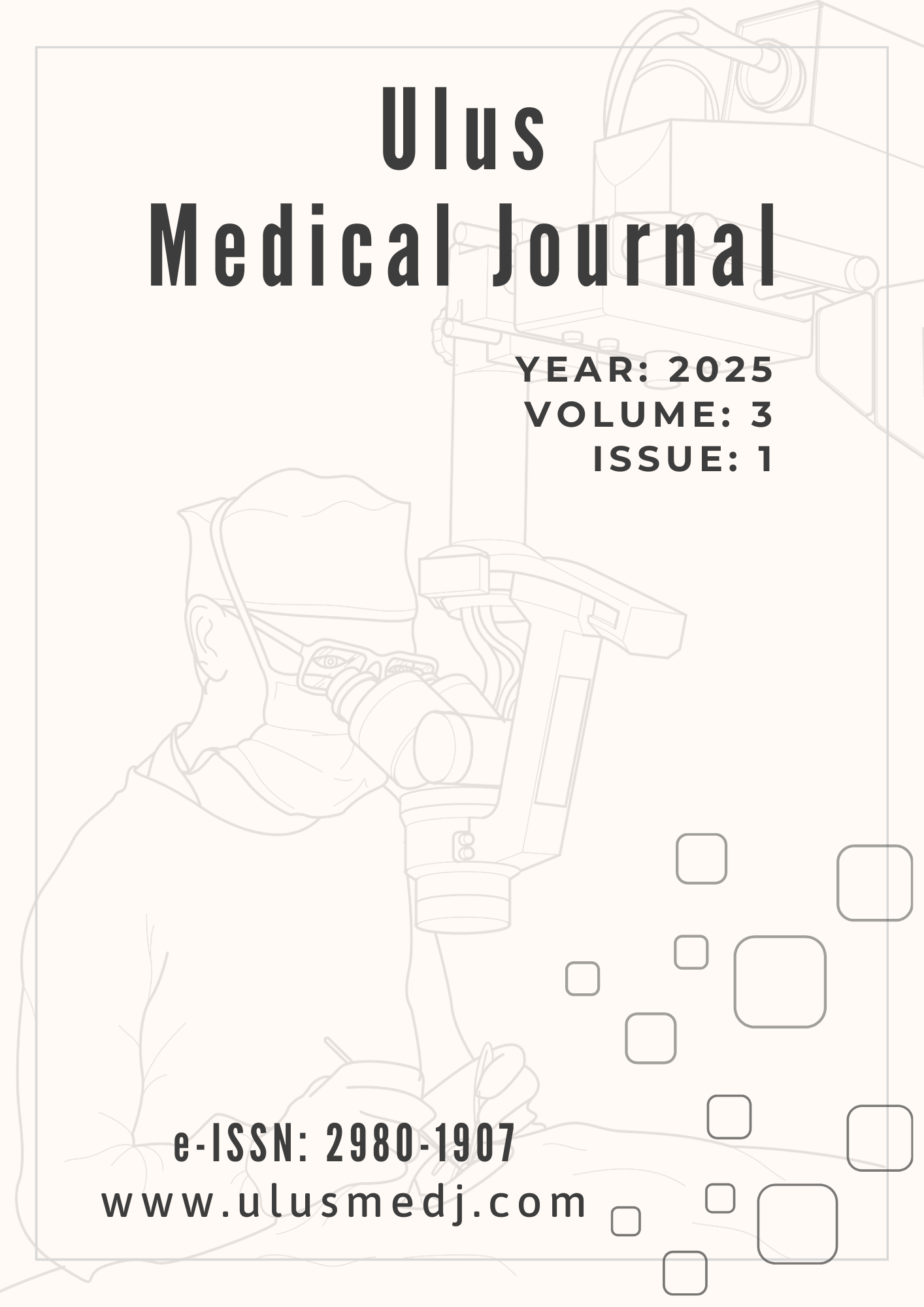Artificial Intelligence in Radiology
AI in Radiology
Keywords:
Radiology, artificial intelligence, machine learning, deep learning, radiomicsAbstract
In radiology and undoubtedly in radiologic anatomy, artificial intelligence (AI) plays an important role in the diagnostic and therapeutic processes by offering revolutionary innovations in the field of imaging. AI algorithms enhance accuracy, speed, and efficiency by analyzing images obtained through methods such as X-rays, computed tomography (CT), magnetic resonance imaging (MRI), and ultrasound (US). Specifically, deep learning (DL) and machine learning (ML) applications enable early diagnosis by detecting fine details. This not only ensures patient safety but also alleviates the workload of radiologists and improves cost-effectiveness. Furthermore, AI offers safer imaging opportunities by reducing radiation doses and improving low-quality images. However, limitations such as data quality, ethical concerns, and patient privacy complicate the integration of AI into healthcare systems. In the future, AI is expected to expand its applications in radiology, offering more accurate diagnostic and therapeutic possibilities.
References
Turing AM. Computing machinery and intelligence. Mind. 1950;LIX(236):433–60.
Yılmaz MÖ, Aydın SO, Baran O. Nöroşirürjide büyük veri ve yapay zekâ: Görüntüleme uygulamaları [Big Data and Artificial Intelligence in Neurosurgery: Imaging Applications]. Türk Nöroşir Derg. 2022;32(2):142–49. Turkish.
Yapay zekâ [Artificial intelligence] [Internet]. Erişim adresi [access address]: https://tr.wikipedia.org/wiki/Yapay_zekâ.
Najjar R. Redefining radiology: A review of artificial intelligence integration in medical imaging. Diagnostics. 2023;13:2760.
Atlan F, Pençe İ. Yapay zekâ ve tıbbi görüntüleme teknolojilerine genel bakış [An Overview of Artificial Intelligence and Medical Imaging Technologies]. Acta Infologica. 2021;5(1):207–30. Turkish.
Özdemir L, Bilgin A. Sağlıkta yapay zekânın kullanımı ve etik sorunlar [The Use of Artificial Intelligence in Healthcare and Ethical Issues]. SHYD. 2021;8(3):439–45. Turkish.
Janssen NE. A machine learning proposal for predicting the success rate of IT-projects based on project metrics before initiation. University of Twente; 2020.
Demšar J, Curk T, Erjavec A, et al. Orange: Data mining toolbox in Python. J Mach Learn Res. 2013;14:2349–53.
Sayar B. Tıp alanında yapay zekânın kullanımı [The Use of Artificial Intelligence in Medicine]. Acta Medica Ruha. 2023;1(1):27–33. Turkish.
Eker AG, Duru N. Medikal görüntü işlemede derin öğrenme uygulamaları [Deep Learning Applications in Medical Image Processing]. Acta Infologica. 2021;5(2):1–16. Turkish.
Er MB. Önceden eğitilmiş derin ağlar ile göğüs röntgeni görüntüleri kullanarak pnömoni sınıflandırılması [Classification of Pneumonia Using Chest X-Ray Images with Pretrained Deep Neural Networks]. Konjes. 2021;9(1):193–204. Turkish.
Robotik [Robotics]. [Internet]. Erişim adresi [access address]: https://tr.wikipedia.org/wiki/Robotik.
İnsan beyni [Human Brain]. [Internet]. Erişim adresi [access address]: https://tr.wikipedia.org/wiki/İnsan_beyni.
Pianykh OS, Langs G, Dewey M, et al. Continuous learning AI in radiology: implementation principles and early applications. Radiology. 2020;297:6–14.
Yu KH, Beam AL, Kohane IS. Artificial intelligence in health care. Nat Biomed Eng. 2018;2(10):719.
Yordanova MZ. The applications of artificial intelligence in radiology: Opportunities and challenges. Eur J Med Health Sci. 2024;6(2):11–4.
Waller J, O’Connor A, Raafat E, et al. Applications and challenges of artificial intelligence in diagnostic and interventional radiology. Pol J Radiol. 2022;87.
Bakas S, Reyes M, Jakab A, et al. Identifying the best machine learning algorithms for brain tumor segmentation, progression assessment, and overall survival prediction in the BRATS challenge. 2018.
Koçak B, Durmaz EŞ, Ateş E, Kılıçkesmez Ö. Radiomics with artificial intelligence: a practical guide for beginners. Diagn Interv Radiol. 2019;25:485–95.
Huang X, Shan J, Vaidya V. Lung nodule detection in CT using 3D convolutional neural networks. In: Proceedings of the IEEE 14th International Symposium on Biomedical Imaging (ISBI); 2017 Apr 18–21; Melbourne, Australia. New York: IEEE; 2017:379–83.
Özçiftçi S, Akpınar A, Dönmez O. Tıp etiği araştırmalarında Q metodolojisi kullanımı: Radyoloji alanında yapay zekâ etiği araştırması örneği [Use of Q Methodology in Medical Ethics Research: An Example of Artificial Intelligence Ethics Study in the Field of Radiology]. Lokman Hekim Dergisi. 2024;14(2):418–29. Turkish.
Ozlu C, Acet A, Korkut B, Yalcin C. Artificial intelligence studies and data analysis in chronic lymphocytic leukemia: A current review. Selcuk Med J. 2024;40(3):146–51.
Vatansever S, Bıyıklıoğlu HF. Sağlık görüntüleme sistemlerinde görüntü işleme ile hastalık teşhisi [Disease Diagnosis Using Image Processing in Medical Imaging Systems]. Yıldız Teknik Üniversitesi; 2021. Turkish.
Long J, Shelhamer E, Darrell T. Fully convolutional networks for semantic segmentation. In: Proceedings of the IEEE Conference on Computer Vision and Pattern Recognition (CVPR); 2015 Jun 7–12; Boston, MA, USA. New York: IEEE; 2015:3431–40.
Ronneberger O, Fischer P, Brox T. U-net: Convolutional networks for biomedical image segmentation. In: International Conference on Medical Image Computing and Computer-Assisted Intervention. Cham: Springer; 2015.
Zhou Z, Siddiquee MMR, Tajbakhsh N, Liang J. Unet++: A nested u-net architecture for medical image segmentation. In: Deep Learning in Medical Image Analysis and Multimodal Learning for Clinical Decision Support. Cham: Springer; 2018:3–11.
Alom MZ, Hasan M, Yakopcic C, et al. Recurrent residual convolutional neural network based on u-net (r2u-net) for medical image segmentation. arXiv preprint arXiv:1802.06955. 2018.
Ibtehaz N, Rahman MS. MultiResUNet: Rethinking the U-Net architecture for multimodal biomedical image segmentation. Neural Netw. 2020;121:74–87.
Sun J, Zhang J, Wen Y, et al. SAUNet: Shape attentive U-Net for interpretable medical image segmentation. In: International Conference on Medical Image Computing and Computer-Assisted Intervention. Cham: Springer; 2020.
Tong X, Chen M, Nie D, et al. ASCU-Net: Attention gate, spatial and channel attention U-Net for skin lesion segmentation. Diagnostics (Basel). 2021;11(3):501.
Li C, Sun S, Liu W, et al. MRFU-Net: A multiple receptive field U-Net for environmental microorganism image segmentation. In: Information Technology in Biomedicine. Cham: Springer; 2021:27–40.
Han C, Hayashi H, Rundo L, et al. GAN-based synthetic brain MR image generation. In: Proceedings of the IEEE 15th International Symposium on Biomedical Imaging (ISBI); 2018 Apr 4–7; Washington, DC, USA. New York: IEEE; 2018:734–38.
Gillies RJ, Kinahan PE, Hricak H. Radiomics: Images are more than pictures, they are data. Radiology. 2016;278:563–77.
van Griethuysen JJM, Fedorov A, Parmar C, et al. Computational radiomics system to decode the radiographic phenotype. Cancer Res. 2017;77.
Szczypiński PM, Strzelecki M, Materka A, Klepaczko A. MaZda—a software package for image texture analysis. Comput Methods Programs Biomed. 2009;94:66–76.
Nioche C, Orlhac F, Boughdad S, et al. LIFEx: A freeware for radiomic feature calculation in multimodality imaging to accelerate advances in the characterization of tumor heterogeneity. Cancer Res. 2018;78:4786–89.
Zhang L, Fried DV, Fave XJ, et al. IBEX: An open infrastructure software platform to facilitate collaborative work in radiomics. Med Phys. 2015;42:1341–53.
Williams GJ. Rattle: A data mining GUI for R. The R Journal. 2009;1:45–55.
Witten IH, Frank E, Hall MA, Pal CJ. Data mining: Practical machine learning tools and techniques. 4th ed. San Francisco: Morgan Kaufmann Publishers Inc; 2016.
Shayesteh SP, Alikhassi A, Fard Esfahani A, et al. Neo-adjuvant chemoradiotherapy response prediction using MRI-based ensemble learning method in rectal cancer patients. Phys Med. 2019;62:111–19.
Serhatlıoğlu S, Hardalaç F. Yapay Zekâ teknikleri ve radyolojiye uygulanması [Artificial Intelligence Techniques and Their Application in Radiology]. Fırat Tıp Dergisi. 2009;14(1):1–6. Turkish.
Mannil M, von Spiczak J, Muehlematter UJ, et al. Texture analysis of myocardial infarction in CT: Comparison with visual analysis and impact of iterative reconstruction. Eur J Radiol. 2019;113:245–50.
Liu Y, Chen J, Hai J, et al. Three-dimensional semi-supervised lumbar vertebrae region of interest segmentation based on MAE pre-training. J Xray Sci Technol. 2025;33(1):270–282.
Downloads
Published
How to Cite
Issue
Section
License
Copyright (c) 2025 Ulus Medical Journal

This work is licensed under a Creative Commons Attribution 4.0 International License.








